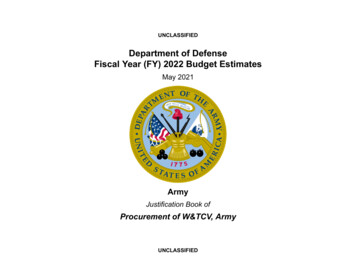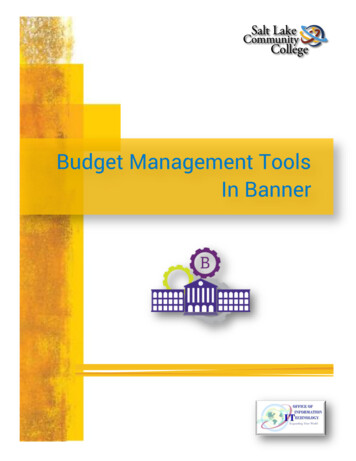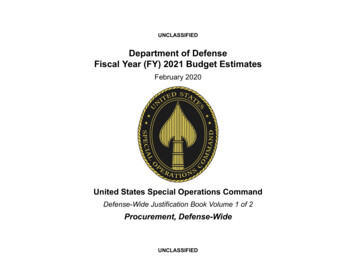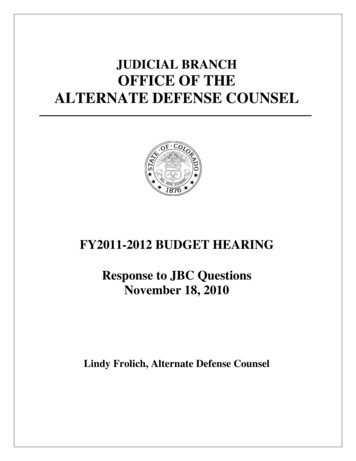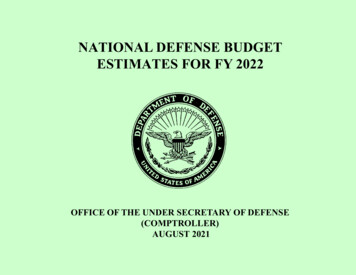
Transcription
NATIONAL DEFENSE BUDGETESTIMATES FOR FY 2022OFFICE OF THE UNDER SECRETARY OF DEFENSE(COMPTROLLER)AUGUST 2021
This Page Intentionally Left Blank
The estimated cost of this report or studyfor the Department of Defense isapproximately 10,000 for the 2021Fiscal Year. This includes 700 inexpenses and 9,510 in DoD labor.Generated on 2021Jun22RefID: 5-83F3DF4
This Page Intentionally Left Blank
Table of ContentsOverview – National Defense Budget Estimates for FY 2022 . 1Chapter 1: National Defense – An Overview. 5Table 1-1: National Defense Budget (FY 2020 to FY 2022) . 6Table 1-2: National Defense Budget Authority – Discretionary and Mandatory; Current andConstant Dollars (FY 2020 to FY 2022) . 7Table 1-3: National Defense Outlays – Discretionary and Mandatory; Current and Constant Dollars (FY 2020 to FY 2022) . 11Table 1-4: Federal Unified Budget – Budget Authority by Function (FY 2020 to FY 2022). 15Table 1-5: Federal Unified Budget – Outlays by Function (FY 2020 to FY 2022) . 16Table 1-6: Discretionary Budget Authority for National Defense (Not Available at this Time). 17Table 1-7: Discretionary Budget Authority for Past Defense Budgets to the Present (FY 2012 to FY 2025). 18Chapter 2: Base Budget, War Funding and Supplementals . 21Table 2-1: Base Budget, War Funding and Supplementals by Military Department, by P.L. Title (FY 2001 to FY 2022). 22Chapter 3: Legislative Authorization . 43Table 3-1: FY 2022 Defense Budget – Reconciliation of Authorization, Appropriation, BA and TOA . 44Table 3-2: Military Personnel Authorizations (FY 2020 to FY 2022) . 51Chapter 4: Chronology . 53Table 4-1: FY 2020 National Defense Budget Authority Chronology . 54Table 4-2: FY 2021 National Defense Budget Authority Chronology . 56Chapter 5: Treatment of Inflation . 57Table 5-1: DoD and Selected Economy-Wide Indices (FY 1970 to FY 2026) . 58Table 5-2: Pay and Inflation Rate Assumptions – Outlays (FY 2020 to FY 2022). 60Table 5-3: Pay and Inflation Rate Assumptions – Budget Authority (FY 2020 to FY 2022) . 61Table 5-4: DoD Deflators – TOA by Public Law Title (FY 1970 to FY 2022) . 62Table 5-5: DoD Deflators – TOA by Category (FY 1970 to FY 2022) . 64Table 5-6: DoD Deflators – Budget Authority by Public Law Title (FY 1970 to FY 2022) . 66Table 5-7: DoD Deflators – Budget Authority by Category (FY 1970 to FY 2022) . 68Table 5-8: DoD Deflators – Outlays by Public Law Title (FY 1970 to FY 2022) . 70i
Table of Contents (Continued)Table 5-9:Table 5-10:Table 5-11:Table 5-12:Table 5-13:DoD Deflators – Outlays by Category (FY 1970 to FY 2022) . 72Chronology of Selected Inflation Profiles (FY 2001 to FY 2026). 74Outlay Rates for Incremental Changes in Budget Authority Purchases . 76Military and Civilian Pay Increases Since 1945 (1945 to 2022) . 79Civilian Pay Deflators by Category (FY 1970 to FY 2022) . 81Chapter 6: TOA, BA, Outlay Trends and Program Changes . 83Table 6-1: DoD TOA by Public Law Title (FY 1948 to FY 2022) . 84Table 6-2: DoD TOA by Category (FY 1948 to FY 2022) . 91Table 6-3: DoD TOA by Military Department (FY 1948 to FY 2022) . 98Table 6-4: DoD TOA by Major Force Program – Current Dollars (FY 1962 to FY 2022) . 105Table 6-5: DoD TOA by Major Force Program – Constant Dollars (FY 1962 to FY 2022) . 107Table 6-6: DoD TOA, BA, and Outlays by Appropriation Account – Current Dollars (FY 2020 to FY 2022) . 109Table 6-7: DoD TOA, BA, and Outlays by Appropriation Account – Constant Dollars (FY 2020 to FY 2022) . 116Table 6-8: DoD Budget Authority by Public Law Title (FY 1948 to FY 2022) . 123Table 6-9: DoD Budget Authority by Category (FY 1948 to FY 2022) . 130Table 6-10: DoD Budget Authority by Military Department (FY 1948 to FY 2022) . 137Table 6-11: DoD Outlays by Public Law Title (FY 1948 to FY 2022). 144Table 6-12: DoD Outlays by Category (FY 1948 to FY 2022) . 151Table 6-13: DoD Outlays by Military Department (FY 1948 to FY 2022). 158Table 6-14: DoD Civilian Pay – Current Dollars (FY 1970 to FY 2022) . 165Table 6-15: DoD Civilian Pay – Constant Dollars (FY 1970 to FY 2022) . 167Table 6-16: Army TOA by Public Law Title (FY 1948 to FY 2022) . 169Table 6-17: Navy TOA by Public Law Title (FY 1948 to FY 2022) . 176Table 6-18: Air Force TOA by Public Law Title (FY 1948 to FY 2022) . 183Table 6-19: Army Budget Authority by Public Law Title (FY 1948 to FY 2022) . 190Table 6-20: Navy Budget Authority by Public Law Title (FY 1948 to FY 2022) . 197Table 6-21: Air Force Budget Authority by Public Law Title (FY 1948 to FY 2022) . 204Table 6-22: Army Outlays by Public Law Title (FY 1948 to FY 2022) . 211ii
Table of Contents (Continued)Table 6-23:Table 6-24:Table 6-25:Table 6-26:Navy Outlays by Public Law Title (FY 1948 to FY 2022) . 218Air Force Outlays by Public Law Title (FY 1948 to FY 2022) . 225DoD Discretionary BA by Public Law Title (FY 2010 to FY 2022) . 232DoD Discretionary BA by Military Department (FY 2010 to FY 2022). 238Chapter 7: Defense, the Public Sector and the Economy . 245Table 7-1: Total Federal Outlays – Current Dollars (FY 1945 to FY 2022) . 246Table 7-2: Total Federal Outlays – FY 2012 Constant Dollars (FY 1945 to FY 2022) . 249Table 7-3: U.S. Public Spending: Federal, State, Local and GDP – Current Dollars (FY 1945 to FY 2022) . 252Table 7-4: U.S. Public Spending: Federal, State, Local and GDP – FY 2012 Constant Dollars (FY 1945 to FY 2022) . 255Table 7-5: Department of Defense Manpower – End Strength/FTE's (FY 1940 to FY 2022). 258Table 7-6: U.S. Labor Force – End Strength/FTE's (FY 1940 to FY 2022) . 261Table 7-7: Defense Shares of Economic and Budgetary Aggregates (FY 1940 to FY 2022) . 264Glossary of Terms . 267Notes . 271iii
This Page Intentionally Left Blank
Overview National Defense Budget Estimates forFiscal Year (FY) 2022Department of DefenseDiscretionary Budget Authority(Dollars in Billions)The National Defense Budget Estimates, commonly referred to as“The Green Book,” is a reference source for data associated with thecurrent budget estimates of the Department of Defense (DoD). Itprovides current (nominal) and constant (real) dollar historical datafor the Department, as well as selected data on all National Defense,the total federal budget, and the U.S. economy. This edition reflectsthe FY 2022 President’s Budget as submitted to the Congress byPresident Biden.The Green Book may be used as a companion to the Budget RequestSummary Justification Book. However, while the Justification Bookspeaks mainly to the Department’s budgetary request in terms ofdiscretionary budget authority, most tables in the Green Bookdisplay combined discretionary and mandatory funding. Thedifference between discretionary and mandatory is discussed later,and can also be found in the Glossary of Terms at the end of thebook.Also to follow is a short guide to understanding the data presented inthis document. There is an explanation of budget authority vs. totalobligational authority, along with outlays. Next is a section ondiscretionary, mandatory and emergency funding. Current vs.constant dollars, a mainstay of inflationary analysis, is then defined,followed by an explanation of deflators. Finally, there is adiscussion of calculation methodologies and how rounding anddifferences in scoring cause disparities between DoD reporting andthat of the Office of Management and Budget (OMB).NOTE: The FY 2022 President’s Budget request includes 42.1 billion for Direct Warand Enduring Operations in the base request.and (3) outlays. While Department analysts may distinguishbetween BA and TOA, BA is what the general public tends torecognize as funding appropriated by Congress. It is the authority tolegally incur binding obligations (signing contracts and placingorders), which will result in current-year and future outlays.On the other hand, TOA is a DoD financial term expressing thevalue of the direct Defense program for a given fiscal year, exclusiveof the obligation authority from other sources (such as reimbursableorders accepted). Here are some more differences between BA andTOA:Budget Authority, Total Obligational Authority and OutlaysGreen Book funding data are provided in three standard categories:(1) budget authority (BA) – discretionary and mandatory authorityare combined in most tables; (2) total obligational authority (TOA);Overview1Overview
If BA expires before obligations are incurred, the TOA for thatyear is reduced by the expired amount. There is no effect on BA. If legislation (proposed or enacted) transfers the unobligatedbalance of one account to another, where the purpose of thebalance has changed, scoring rules require the transfer to bereflected as a change in BA in the year in which the transferoccurred (reduction of BA in the losing account, increase of BAin the gaining account). The adjustment to TOA will be in theoriginal program, regardless of when the transaction occurred. Reappropriations (the extension of availability of previouslyappropriated funds) are scored as BA in the first year of extendedavailability, while TOA is unchanged. Rescissions (congressional action canceling new BA orunobligated balances) are reflected as a reduction to BA in thefiscal year in which the rescission is enacted. However, TOAreflects this adjustment in the program year of the rescindedfunds (i.e., the fiscal year in which the funds were originallyappropriated). If rescissions are proposed in the budget, theywould be reflected in the TOA as if enacted. For acquisition and construction programs, the Department operatesunder a “full funding” policy by which Congress approves, in theyear of the request, sufficient funds to complete a given quantity ofitems or build a facility, even though it may take a number of yearsto actually build and deliver these items. Thus, in exceptional cases(such as the building of an aircraft carrier), final outlays may berecorded a decade after the BA for the program was originallygranted.Discretionary, Mandatory, and Emergency ProgramsDiscretionary programs are funded annually through thecongressional appropriations process. The scorekeeping guidelinesof the Budget Enforcement Act (BEA) establish annual limits on theamount of BA available for these programs.Adjustments to discretionary spending limits are provided forspending that is designated by both Congress and the President asemergency requirements, or for supplemental war funding – on anaccount-by-account basis.Mandatory programs, also known as “pay-as-you-go” or PAYGOprograms, are direct spending programs and receipts defined asentitlement authority. This is BA authorized by permanent law,rather than annual appropriations acts. Social Security and Medicareare examples of mandatory programs. Military retirement andMedicare-Eligible Retiree Health Fund Contribution accounts areexamples of DoD-specific mandatory programs. The Pay-As-YouGo Act of 2010 establishes the current guidelines for scorekeepingof mandatory programs.Net offsetting receipts (collections from the public that arise outof business-type or market-oriented activities of the federalgovernment, and are deposited in receipt accounts) are deductedfrom BA, but have no effect on TOA.The third category of data reflected in this book is outlays, alsoknown as expenditures or disbursements. Outlays are the liquidationof the federal government’s obligations and generally represent cashpayments. Outlays in a given fiscal year may represent theliquidation of obligations incurred over a number of years. There isa time lag between budgeting funds (congressional appropriation),signing contracts and placing orders (obligations), receiving goods orservices, and making payments (liquidation of obligations).OverviewThe Department of Defense is unique in that it is one of the fewfederal entities where the majority of its funding falls into thediscretionary category. The majority of the entire federal budget ismandatory, and much of the discretionary funding in the budget iscomprised of DoD dollars.2Overview
this edition (except for Chapter 7, where the base year used by OMB– FY 2012 – is applied). An item that has a deflator of 50.00 has acurrent dollar value that is half of what you would need to purchasethe same item in FY 2022. An item that has a deflator of 200.00 hasa current dollar value that is twice what you would need to purchasethe same item in FY 2022.Current Dollars and Constant DollarsThe Green Book displays funding in both current and constantdollars. If an item or service is priced in current dollars, the priceincludes all inflationary changes expected to occur in the programover the duration of the spendout of that program’s appropriation.Constant dollars measure the value of purchased goods and servicesat price levels that are the same as the base year level. Constantdollars do not contain any adjustments for inflation that haveoccurred outside the base year. Thus, by looking at funding acrossvarious years in constant dollars, the only changes a person will seeare programmatic (referred to as “real” change). This will show howmuch spending has changed for a program, without the impact ofinflation.Formula for calculating a deflator when you have the current andconstant dollar values:Current Constant Deflator X 100Converting current dollars to constant dollars:Through understanding current and constant dollars, variations inpurchasing power become more evident. If one dollar buys onewidget in 2010, but in 1950 one dollar purchased five widgets,purchasing power has declined. A current-dollar analysis showsDoD spending much more now than it did in 1950, but a constantdollar analysis reveals that the percentage of program growth (its“real growth”) is not as great as the overall nominal growth.Constant Current DeflatorX 100Example: Converting FY 2004 total DoD budget authority toFY 2022 constant dollars:It is important to note that many inflation indices, such as the GrossDomestic Product (GDP) index, are chain-weighted. This meansthey account for differences in products purchased over the years;new expenditure patterns are accounted for in the inflation figure.For example, if typewriters were regularly purchased in 1970, but by2000 had become obsolete in favor of PCs, a chain-weighted indexwould account for this new purchasing pattern.FY 2004 deflator 69.07DeflatorsCalculation Methodology and RoundingDeflators are a way to measure broad price movements in theeconomy. The deflator in the base year equals 100, and in the GreenBook the default base year is the budget request year – FY 2022 inDoD uses inflation rates provided by OMB as a baseline. OMBbases their rates on Gross Domestic Product (GDP) composite rates.DoD includes military and civilian pay raise rates, fuel rates, andOverviewFY 2004 budget authority (current ) 471,011 millionFY 2004 budget authority in FY 2022 constant dollars: 471,011M69.073X 100 681.9 billion FY 2022 constant dollarsOverview
data were derived from numbers rounded to the thousands.medical factors in its composite rates. In addition, outlay rates foreach appropriation account are factored into the final DoD inflationrates.Further, OMB and DoD sometimes differ in how they report itemslike contract authority and transfers to other federal agencies (i.e.the Coast Guard), which impacts the total dollars reported. In thoseinstances where a discrepancy exists, a delta is displayed as “scoringand rounding.” Finally, in some tables, small differences betweenthe totals shown and the actual sum of the column or row entries arepossible. These discrepancies are also due to rounding.There are some discrepancies between the funding totals shown inthis book and those in OMB publications. These differences resultfrom the way account totals are calculated and scored. Forexample, beginning with the FY 1998 budget, OMB worked withdata that had been rounded to the millions of dollars, while DoDOverview4Overview
Chapter 1: National Defense – An Overview(subfunction 053), and Defense-Related Activities of other federalagencies (subfunction 054). Dollar amounts are provided as BA,TOA or outlays.This chapter provides an overview of the National Defensefunction of the federal budget. The National Defense function(function 050) is comprised of: DoD Military activities(subfunction 051), Atomic Energy Defense ActivitiesTables1-11-21-31-41-51-61-7PageNational Defense Budget (FY 2020 to FY 2022).National Defense Budget Authority – Discretionary and Mandatory; Current and Constant Dollars (FY 2020 to FY 2022).National Defense Outlays – Discretionary and Mandatory; Current and Constant Dollars (FY 2020 to FY 2022).Federal Unified Budget – Budget Authority by Function (FY 2020 to FY 2022).Federal Unified Budget – Outlays by Function (FY 2020 to FY 2022).Discretionary Budget Authority for National Defense (Not Available at this Time ).Discretionary Budget Authority for Past Defense Budgets to the Present (FY 2012 to FY 2025).Introduction5671115161718Chapter 1
Table 1-1: NATIONAL DEFENSE BUDGET(Dollars in Millions)Function and SubfunctionFY 2020FY 2021FY 2022Current DollarsBudget AuthorityDepartment of Defense (Discretionary) .Department of Defense (Mandatory) .051 - Total Department of Defense (DoD Record) .Scoring and Rounding1 .051 - Total Department of Defense (OMB Record)2 .053 / 054 - Energy and Defense-Related2 .050 - Total National Defense2 27,88013727,89340,388768,281Total Obligational Authority051 - Total Department of Defense 0727,880727,89340,388768,281Total Obligational Authority051 - Total Department of Defense .755,312725,486715,115Outlays051 - Total Department of Defense (DoD Record) .051 - Total Department of Defense (OMB Record) .053 / 054 - Energy and Defense-Related .050 - Total National Defense 2,204729,444729,45241,115770,567Outlays051 - Total Department of Defense (DoD Record) .Scoring and Rounding3 .051 - Total Department of Defense (OMB Record)2 .053 / 054 - Energy and Defense-Related2 .050 - Total National Defense2 .FY 2022 Constant DollarsBudget AuthorityDepartment of Defense (Discretionary) .Department of Defense (Mandatory) .051 - Total Department of Defense (DoD Record) .051 - Total Department of Defense (OMB Record) .053 / 054 - Energy and Defense-Related .050 - Total National Defense .NOTE: War and supplemental funding is included.1. DoD is reporting funding transactions for Other Trust Fund accounts that OMB is not: 15M in FY 2020, 4M in FY 2022. Funding transactions OMB is reporting that DoD is not: Working CapitalFund, DCSA: 37M in FY 2020; Host Nation Support Fund for Relocation: 22M in FY 2020, 23M in FY 2022; National Defense Stockpile Transaction Fund: - 14M in FY 2021, - 14M in FY 2022; 9M in FY 2022 belonging to a Department of Homeland Security account temporarily recorded in the Department of Defense budget subfunction.2. From OMB Historical Table 3.2 (Outlays by Function and Subfunction), and Historical Table 5.1 (Budget Authority by Function and Subfunction).3. In FY 2021, DoD is reporting 47M in DoD Closed Accounts that OMB is not.Table 1-16Chapter 1
Table 1-2: NATIONAL DEFENSE BUDGET AUTHORITY - DISCRETIONARY AND MANDATORY(Dollars in Millions)Function and Subfunction051 - Dept of Defense DiscretionaryMilitary Personnel (No MERHFC) .Operation and Maintenance .Procurement .RDT&E .Revolving and Management Funds .Department of Defense Bill (No MERHFC) .Medicare-Eligible Ret Health Fund Contr .Department of Defense Bill Plus MERHFC .Military Construction .Family Housing .Military Construction Bill .Allowances .051 - Total DoD Discretionary (DoD Record) .Scoring and Rounding .051 - Total DoD Discretionary (OMB Record)2 .051 - Dept of Defense MandatoryMilitary Personnel .Operation and Maintenance .Procurement .RDT&E .Revolving and Management Funds .Department of Defense Bill .Military Construction .Family Housing .Military Construction Bill .Trust Funds .Offsetting Receipts .Interfund Transactions .051 - Total DoD Mandatory (DoD Record) .Scoring and Rounding3 .051 - Total DoD Mandatory (OMB Record)2 .FY 20201FY ,21568,50868,158350350FY ,316703,723-2703,721672,91514,316Direct 50-1,654-8012,880412,8841. FY 2020 amounts include war and supplemental funding. For the FY 2022 President's Budget request, war funding was included in the base budget.2. From OMB Historical Table 5.4 (Discretionary Budget Authority by Agency) and Analytical Perspectives Table 20-1 (Net Budget Authority and Outlays By Function, Category, and Program).3. DoD is reporting funding transactions for Other Trust Fund accounts that OMB is not: 15M in FY 2020, 4M in FY 2022. Funding transactions OMB is reporting that DoD
“The Green Book,” is a reference source for data associated with the current budget estimates of the Department of Defense (DoD). It provides current (nominal) and constant (real) dollar historical data for the Department, as well as selected data on all National Defense, the total ed



